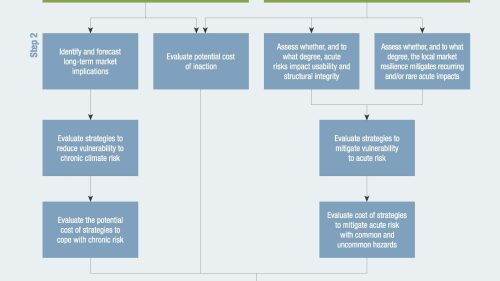Downtowns and urban neighborhoods are seeing new grocery store development, with a revolution in store design, location in mixed-use projects, parking solutions, and role within neighborhoods. In addition, in 2011 there will be tremendous churn in the grocery market, with much of it focused on cities. With traditional grocers like A & P filing for bankruptcy, independent grocers and national chains alike are licking their chops, seeking a place in the multiple-niche urban environment.
Washington, D.C., has several recent examples of large-scale mixed-use projects with grocery store anchors in a dense, walkable urban environment. Perhaps the best is Cityvista, developed by Lowe Enterprises Real Estate Group and designed by Torti Gallas. It opened in 2008 and includes a 55,000-square-foot “Urban Lifestyle Safeway” grocery store as part of a large mixed-use development with 441 condominiums, 244 apartments, and 75,000 square feet of additional retail including a hardware store, a dry cleaners, a bookstore, a gym, and restaurants, all on a 3.2-acre site.
With a split between customers arriving on foot or by car, a key for the design of the store was to get one entrance to face the parking structure and the other to be an attractive pedestrian entrance off the street. Parking was reduced 40 percent versus a conventional suburban store, and the ratio is just 2.9 spaces per 1,000 square feet of store space. This works in a dense urban environment, not only with the 685 residential units within Cityvista itself but thousands of additional housing units providing substantial customers within walking distance. Moreover, the urban lifestyle that Safeway understands is that the urban shopper is more likely to shop once a day rather than once a week, and thus places a bigger emphasis on prepared foods and produce.
While Safeway features a store as part of a mixed-use development in the Pearl District in Portland, Oregon, perhaps more noteworthy is the New Seasons Market on Hawthorne Boulevard in the southeast portion of the city. Opened in August 2010, the New Seasons on Hawthorne is the locally based company’s tenth store, and exemplifies a full-service store in a small format with strong ties to the neighborhood.
With 16,000 square feet of retail space squeezed onto a 19,800-square-foot site, parking was pushed to the rooftop, allowing for a strong pedestrian entrance and good urban presence facing the street. Its 37 parking spaces (2.3 spaces per 1,000 square feet) are augmented by 90 bicycle parking spaces. “Peak-time parking is pretty full,” notes Greg Herrenbruck, director of design and construction for New Seasons Market.
Knowing they couldn’t stamp down a boilerplate design, Herrenbruck and his team held several meetings with neighborhood groups to focus on design. Out of those not only came a number of “green” features such as recycled construction materials and a bioswale to catch rainwater, but also a walk-up coffee window located next to an outdoor seating area that opens an hour before the store itself—yet another aspect of pedestrian-friendly design. Herrenbruck notes that the store has become a gathering place for the neighborhood.
Wal-Mart also is looking to build in more urban settings. In 2010, the retailer announced that 51 percent of its sales are from grocery-related products. In 2010, Wal-Mart announced plans to build four stores in Washington, D.C., part of a move into several new urban markets. In a notable break from tradition, one of the D.C. stores will have 75,000 square feet on the ground floor of a mixed-use building with 315 apartments above. The development is a joint venture between JBG Rosenfeld Retail and the Bennett Group, both based in the Washington area.
Wal-Mart is also proposing smaller-format stores with as little as 20,000 square feet of space, called Wal-Mart Express, with a heavy emphasis on groceries. One of its first stores announced is a 26,491-square-foot Wal-Mart Express in the Presidential Towers in Chicago’s West Loop neighborhood. (See the active discussion of members of the ULI Linkedin Group taking place on the topic of Wal-Mart’s proposed plans.)
Fresh & Easy Market, a division of British-owned Tesco, is expanding in northern California with 10,000- to 12,000-square-foot urban and suburban stores. Among the stores slated to open this year is one in the Hunter’s Point/Bayview neighborhood of San Francisco. It will be in the ground floor of a mixed-use development that includes 239 residential units developed by the Holliday Group, and be located at a station along the Third Street Muni line.
On the ultra-small and uber-local scale, Local D’Lish in Minneapolis, Minnesota, provides a walkable alternative for residents of the North Loop, a growing residential neighborhood near the downtown. With an austere 2,000-square-foot store, owners Ann and Yulin Yin focus on locally sourced groceries and great customer service. Mayberry Foodstuffs in downtown Cincinnati, Ohio, is even smaller at 550 square feet, but both seek to fill a void among area residents for a convenient, walkable grocery store.
Large and small retailers, from Wal-Mart and Safeway on down to Local D’Lish and Mayberry Foodstuffs, are reshaping the urban grocery experience. How it all plays out in the next year and beyond will be interesting, but this much is certain: Development opportunities abound for those who can get the design, mix of uses, and business model right.








